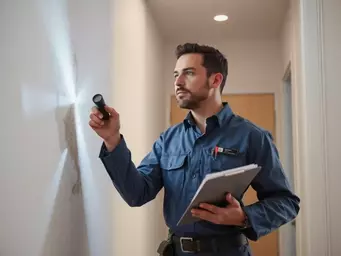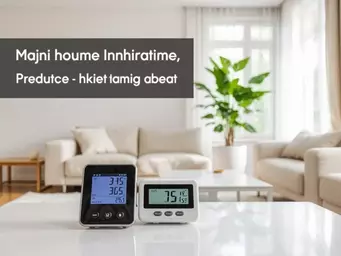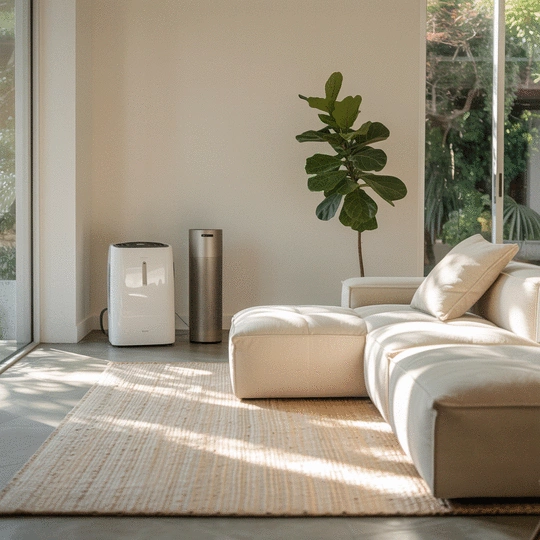Manage Home Humidity to Prevent Mold

Posted on: 2025-11-02
By: Jordan Blake
Did you know that maintaining indoor humidity below 60% can significantly reduce the risk of mold growth in your home? Understanding how humidity affects mold is crucial for ensuring a healthy living environment.
What You Will Learn
- High humidity levels above 60% create ideal conditions for mold growth in homes.
- Common sources of indoor humidity include cooking, showering, drying clothes indoors, and leaks.
- Visible mold spots, musty odors, condensation, and peeling paint are key indicators of high humidity and potential mold issues.
- Utilizing dehumidifiers and humidistats can effectively manage indoor humidity and prevent mold development.
Humidity's Role in Mold Growth and Prevention Strategies
This visual outlines the causes and effects of high humidity leading to mold growth, alongside key strategies for effective management and prevention, ensuring a healthier home environment.
Causes of High Indoor Humidity
- Cooking & boiling water
- Long showers (poor ventilation)
- Drying clothes indoors
- Leaks (roofs, plumbing, windows)
- Weather & climate (coastal, cold)
Effects of Excess Humidity & Mold
- Mold thrives above 60% humidity
- Visible mold spots on surfaces
- Musty odors, persistent condensation
- Peeling paint or wallpaper
- Health risks (allergies, respiratory issues)
Strategies for Managing Humidity
- Utilize dehumidifiers (desiccant, refrigerant, whole-house)
- Incorporate humidistats for control
- Ensure proper ventilation (fans, open windows)
- Regularly inspect high-humidity areas
- Maintain HVAC filters & consider professional inspections
Proactive Steps & Resources
- Monitor humidity levels with hygrometers
- Assess home for humidity vulnerabilities
- Understand homeowners insurance for mold
- Document progress and adjust strategies
- Seek professional assistance for significant mold issues
Understanding the Impact of Humidity on Mold Growth
As a mold remediation expert, I can tell you that humidity plays a crucial role in mold growth. High humidity levels create a perfect breeding ground for mold spores, which can lead to significant health risks and property damage. It's essential to understand the factors that contribute to humidity in your home and how they influence mold development. Let's break this down!
Recognizing the Causes of High Humidity in Your Home
Identifying the sources of humidity in your living space is the first step towards effective management. High humidity can stem from various everyday activities and environmental factors.
Common Sources of Indoor Humidity
- Cooking and boiling water during meal preparation
- Taking long showers without proper ventilation
- Drying clothes indoors
- Leaks from roofs, plumbing, or windows
Each of these activities can elevate the moisture levels inside your home. It's vital to stay aware of these sources and address them promptly to prevent mold issues.
The Role of Weather and Climate in Humidity Levels
The climate in your area significantly impacts indoor humidity. In regions with high humidity, such as coastal areas, it’s easy for moisture to seep into homes. Conversely, cold weather can cause condensation on windows and walls, leading to dampness. Understanding your local weather patterns can help you anticipate and mitigate humidity levels effectively.
Identifying the Effects of Excess Humidity
Once you recognize the causes of high humidity, it’s essential to understand its effects. Excess moisture can lead to severe mold growth and other issues in your living environment. Let’s dive into these effects.
How High Humidity Contributes to Mold Development
Mold thrives in moist environments. When humidity levels exceed 60%, it's only a matter of time before mold takes hold, especially in areas that are dark and poorly ventilated. This is why maintaining a balanced humidity level is key to mold prevention!
Mold Growth Conditions: What to Watch For
- Visible mold spots on walls or ceilings
- Musty odors lingering in the air
- Condensation on windows and pipes
- Peeling paint or wallpaper
If you notice any of these signs, it may be time to inspect your home more closely for mold and moisture issues. Awareness is your first line of defense!
Health Risks Associated with Mold Exposure
Being exposed to mold can lead to various health problems, including allergies, respiratory issues, and skin irritation. If you or your loved ones experience symptoms like coughing, sneezing, or skin rashes, consider checking for hidden mold. It's essential to tackle these issues promptly for the health and safety of your household.
Effective Strategies for Managing Humidity
Managing humidity effectively can save you from the headache of mold remediation down the line. Here are some tried-and-true strategies to help keep humidity in check.
Utilizing Dehumidifiers: Choosing the Right One for Your Space
Dehumidifiers can be a fantastic solution for reducing excess moisture. They remove humidity from the air, making your living environment less hospitable for mold growth.
How Dehumidifiers Work to Reduce Humidity
Dehumidifiers draw in air, passing it over cold coils that condense water vapor. The resulting moisture collects in a reservoir, allowing you to maintain a comfortable humidity level in your home. They’re particularly useful in basements, bathrooms, and other areas prone to dampness.
Comparing Different Types of Dehumidifiers
- Desiccant dehumidifiers – ideal for low temperatures and small spaces
- Refrigerant dehumidifiers – best for larger areas and higher humidity
- Whole-house dehumidifiers – integrated into your HVAC system for comprehensive humidity control
Choosing the right type for your needs can make all the difference in keeping your home mold-free.
Incorporating Humidistats for Optimal Control
Using a humidistat alongside your dehumidifier can help you monitor and control humidity levels more effectively. These devices automatically adjust the dehumidifier's operation based on the current indoor humidity, ensuring that your home remains at an optimal level for comfort and mold prevention.
Pro Tip
To effectively combat mold growth, aim to keep indoor humidity levels below 60%. You can achieve this by using a hygrometer to monitor humidity levels and employing dehumidifiers in high-risk areas like basements and bathrooms. Regularly inspect these spaces for signs of moisture and take proactive measures to maintain a balanced environment!
Summarizing Key Points on Humidity Control and Mold Prevention
At Mold Removal Care, we believe that understanding the relationship between humidity control and mold prevention is essential for maintaining a healthy home. This summary encapsulates the key points we've discussed throughout our article, reinforcing the importance of proactive measures.
Taking control of humidity not only safeguards your home but also enhances the well-being of everyone who lives there. So, let's delve into some crucial strategies that can help you manage humidity effectively and prevent mold growth!
Taking Proactive Steps for a Healthier Home Environment
Regular maintenance is crucial when it comes to preventing mold and managing humidity levels. Establishing a routine can help you spot potential issues before they escalate. For example, checking your basement or attic for moisture regularly can prevent significant problems down the line!
- Inspect high-humidity areas such as bathrooms and kitchens.
- Change HVAC filters regularly to improve airflow.
- Consider scheduling seasonal professional inspections.
Additionally, encouraging continuous monitoring of humidity levels can help you maintain a balanced indoor environment. Using tools like hygrometers can inform you when humidity spikes, prompting you to take action.
Lastly, understanding the role of your homeowners insurance in mold issues can be a game-changer. It’s wise to review your policy regarding mold coverage, which can save you unexpected expenses if mold does become a problem.
Engaging with Expert Insights and User Experiences
Incorporating testimonials from homeowners who have successfully managed humidity can provide inspiration. Many have shared their experiences with controlling mold growth by implementing simple yet effective strategies, like using dehumidifiers or improving ventilation.
- "After installing a dehumidifier, I noticed a significant drop in musty odors!" - Sarah, homeowner
- "Regular inspections made a world of difference in preventing mold in my basement." - Mark, property manager
- "The tips I found here really helped my family breathe easier!" - Lisa, homeowner
Moreover, expert interviews can highlight various solutions for humidity control. We've spoken with specialists who recommend specific products and practices that can elevate your home's air quality significantly!
Encouraging Action: Your Next Steps for Mold Prevention
Now that we’ve covered these essential points, it’s time to take action. Implementing the recommended strategies today can lead to a significant improvement in your living environment.
Implementing the Recommended Strategies Today
Creating a humidity management plan for your home is a crucial first step. Consider which areas of your home are most vulnerable and prioritize strategies based on your specific situation. For instance, if you have a damp basement, installing a dehumidifier might be your best bet!
- Assess your home for humidity vulnerabilities.
- Set clear goals for reducing humidity levels.
- Document your progress and adjust strategies as needed.
Additionally, ensure you have the right resources and tools for ongoing support. Whether it’s using monitoring devices or keeping up-to-date with our latest articles, staying informed is key to proactive management.
Lastly, understanding the importance of professional services for remediation cannot be overstated. If you encounter significant mold issues, seeking expert help can ensure a thorough solution, protecting your home and health effectively!
Frequently Asked Questions About Humidity and Mold
- What is the ideal indoor humidity level to prevent mold growth?
- The ideal indoor humidity level to prevent mold growth is below 60%, with many experts recommending between 30% and 50%.
- What are common sources of high indoor humidity?
- Common sources include cooking, long showers, drying clothes indoors, and leaks from roofs, plumbing, or windows.
- What are the signs of excess humidity and potential mold issues?
- Signs include visible mold spots, musty odors, persistent condensation on windows or pipes, and peeling paint or wallpaper.
- How do dehumidifiers prevent mold growth?
- Dehumidifiers reduce humidity by drawing in air and condensing water vapor, thereby making the environment less hospitable for mold spores to thrive.
- Are there different types of dehumidifiers for different needs?
- Yes, there are desiccant dehumidifiers (for low temperatures/small spaces), refrigerant dehumidifiers (for larger areas/higher humidity), and whole-house dehumidifiers (integrated with HVAC for comprehensive control).
- What are the health risks associated with mold exposure?
- Mold exposure can lead to various health problems such as allergies, respiratory issues, coughing, sneezing, and skin irritation.
- How can I proactively monitor humidity levels in my home?
- You can monitor humidity levels using hygrometers. Incorporating humidistats with your dehumidifier also allows for automatic control.
- When should I seek professional assistance for mold issues?
- You should seek professional assistance if you encounter significant mold issues that are too extensive to handle yourself, or if you suspect hidden mold and are experiencing health symptoms.
Recap of Key Points
Here is a quick recap of the important points discussed in the article:
- High humidity levels above 60% create ideal conditions for mold growth.
- Common sources of indoor humidity include cooking, long showers, and leaks.
- Visible mold spots, musty odors, and condensation are signs of excess humidity.
- Dehumidifiers are effective tools for managing moisture in the home.
- Regular inspections and maintenance can prevent mold issues before they escalate.
- Understanding your homeowner's insurance policy can help mitigate costs related to mold remediation.
 When it comes to mold, proactive measures are crucial. Ignoring its presence can lead to serious hea
When it comes to mold, proactive measures are crucial. Ignoring its presence can lead to serious hea
 Did you know that maintaining indoor humidity below 60% can significantly reduce the risk of mold gr
Did you know that maintaining indoor humidity below 60% can significantly reduce the risk of mold gr
 What if your home was hiding a silent intruder that could affect your health and property value? Mol
What if your home was hiding a silent intruder that could affect your health and property value? Mol
